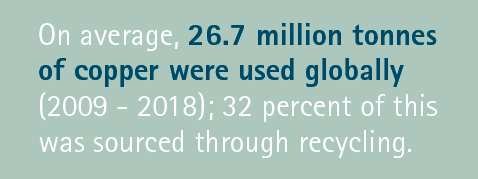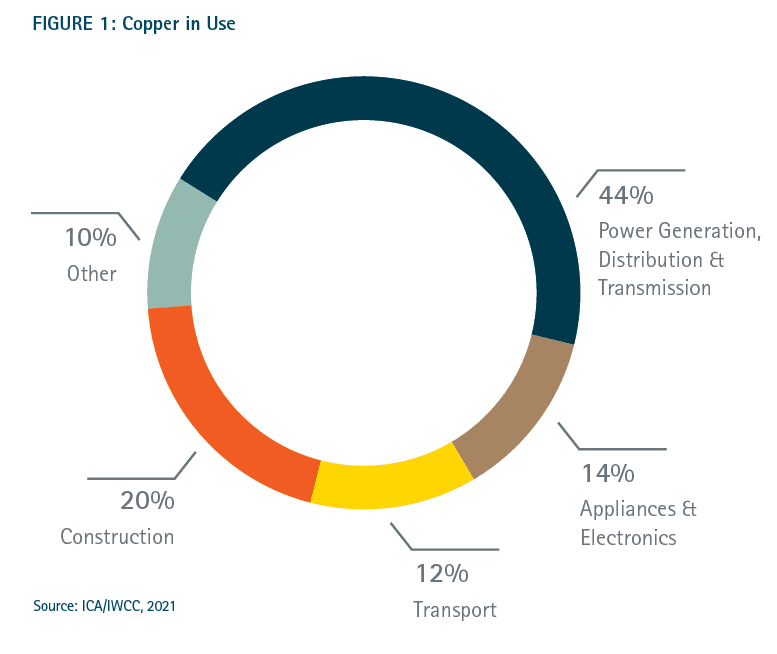The Importance of Recycling
During the past decade, strong growth in emerging economies, coupled with an increased use of copper for innovative and clean energy technologies, has led to significantly higher copper demand. The recovery and recycling of copper helps to satisfy this demand and to build a sustainable future for people and the planet.
Copper is 100% Recyclable
Copper is one of the few materials that can be recycled repeatedly without any loss of performance. There is also no difference in the quality of recycled copper (secondary production) and mined copper (primary production), thus they can be used interchangeably.
Recycling Reduces CO2 Emissions and Energy Use
Recycling copper is a highly eco-efficient way of reintroducing a valuable material back into the economy. The recycling of copper requires less energy than primary production and reduces CO2 emissions.
In addition to its environmental benefits, the recycling of complex copper scrap, such as electronic waste, drives the recovery of many other metals such as gold, silver, nickel, tin, lead and zinc.
Copper in Use
It is estimated that in the last one hundred years, two-thirds of the 690 million tonnes of copper produced are still in productive use. Nearly 70 percent of worldwide copper produced is used for electrical/conductivity applications and communications.
Copper has the highest electrical conductivity of any metal, apart from silver. This property makes copper the material of choice in power generation and transmission (44 percent of use)—delivering electricity safely and efficiently to homes and businesses.
Electrical equipment—providing circuitry, wiring and contacts for appliances and consumer electronics—accounts for 14 percent of copper usage.
The remaining 12 percent is used by the transport sector. The high purity copper wire harness system in a train, car or truck carries the current from the battery throughout the vehicle to equipment such as lights, central locking, on-board computers and satellite navigation systems.
Another 20 percent of all the copper produced is used in buildings—for plumbing, cooling, roofing and cladding. Copper provides light, durable maintenance-free structures that are naturally good looking, long lasting and fully recyclable.
The remaining 10 percent is used for coins, sculptures, jewelry, musical instruments, cookware and other consumer goods.
This enormous stock of copper, contained in its diverse range of end uses and equivalent to around 33 years of mine production, is often referred to as society’s “urban mine.”
Copper, the Recycling Champion

Currently, a total of around 8.7 million tonnes of copper per year come from the recycling of “old” scrap (copper contained in end-of-life products) and “new” scrap (generated during production and downstream manufacturing processes). The figure below shows how recycling is a core part of the overall copper value chain.
Summary
Copper is one of the few materials that can be recycled repeatedly without any loss of performance. As well as helping to satusfy the annual demand for copper, recycling conserves valuable natural resources, saves energy and reduces CO2 emissions.
Copper recycling contributes to a progressive move toward a more circular economy. However, the loop cannot be completely closed for two reasons. First, demand will continue to increase due to population growth, product innovation and economic development. Second, in most applications, copper stays in use for decades before being ready to recycle and use again. Consequently, the growing demand for copper will require a combination of raw materials coming from mines (primary copper), as well as from recycled materials (secondary copper). During the last decade about 32 percent of annual copper use came from recycled sources.
Sitting at end of the recycling value chain, the copper industry plays a crucial role by “closing the loop” and is constantly investing and innovating to ensure the circular management of metals. However, it is more difficult to collect and reprocess increasingly complex materials containing copper such as electronic scrap. Therefore, endeavors supporting recycling can be implemented in new product design to facilitate end of life recovery and the industrial recycling processes to increase overall yields. In addition, regulatory policies must continue to encourage recovery and recycling, both at the industry level and by the individual citizen.

